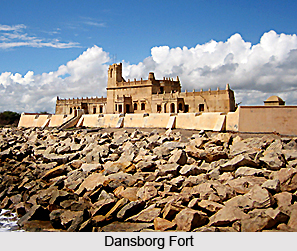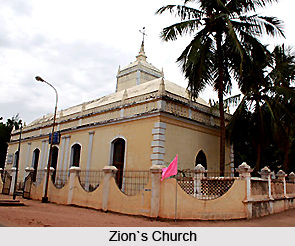Monuments of Tranquebar comprise the Dansborg fort and several churches which were primarily constructed under the Dutch regime. This city is located in the Nagapattinam district of Tamil Nadu near the mouth of a distributary of the Kaveri River. From 1620 to 1845 Tranquebar was a Danish colony as it was purchased by the Danish East India Company from the Nayaka Rangunatha of Tanjore in 1620. However, the depression in the 1800s and the arrival of the British altered the fate of this South Indian region. The depression, in particular, resulted in huge losses for the Danish settlement in Tranquebar and they eventually sold their trading rights to the British East India Company in 1845. The Danish rulers, however, beautified their territory with a number of edifices. Whilst some of these were historical, others were primarily religious in nature.
 One of the most popular monuments of Tranquebar is the Dansborg Fort. It was built in 1620 by Ovo Gedde and was subsequently strengthened and extended in 1749 and in the 1780s.The fort was built with the intention of housing rooms for the governor, merchants and chaplain on the first floor, while the entire lower floor was used as a warehouse especially for the silks and spices. The fort is in North-South orientation with doors at the East for ingress and a veranda on the West. The central portion of the fort has four camel humps shaped domes on the roof with tie rods functioning as stays. The domes are rectangular in shape and very large in size. A central hall in the pillar bore the weight of the dome. The northern and southern portions have barrel vaulted roofs.
One of the most popular monuments of Tranquebar is the Dansborg Fort. It was built in 1620 by Ovo Gedde and was subsequently strengthened and extended in 1749 and in the 1780s.The fort was built with the intention of housing rooms for the governor, merchants and chaplain on the first floor, while the entire lower floor was used as a warehouse especially for the silks and spices. The fort is in North-South orientation with doors at the East for ingress and a veranda on the West. The central portion of the fort has four camel humps shaped domes on the roof with tie rods functioning as stays. The domes are rectangular in shape and very large in size. A central hall in the pillar bore the weight of the dome. The northern and southern portions have barrel vaulted roofs.
The fort is now a museum maintained by the State Archaeological department of Tamil Nadu which exhibits a collection of artefacts from the time of Danish presence in the region. This includes Danish articles, Danish coins, palm leaf, terracotta figures and bowls and even the weapons used by them like swords and spears.
The Zeigenbalg Monument pays homage to the achievements of Barthlomeus Zeigenbalg, and Plutschau of Germany. On he orders of the Danish King Frederick IV they arrived in India with the aim of providing religious and public services here. They were keenly interested in learning the Tamil language and Zeigenblag mastered the language in two years. He translated a Tamil book titled "Ulaga Needhi" (Universal Justice) into German. An international exhibition at London hosts another of his great works titled, "An account of the Malabarians." The press was utilized to print the first Tamil version of the Holy Bible (New Testament) in 1715 AD.
 The Town Gateway was built in 1792 on Danish Architectural style. The Danes constructed a big wall all around the settlement of Tranquebar, which they modelled after small European towns of the 17th Century AD. The Land Gate with wooden doors was the way leading to Kings Street was constructed during 1792 AD.
The Town Gateway was built in 1792 on Danish Architectural style. The Danes constructed a big wall all around the settlement of Tranquebar, which they modelled after small European towns of the 17th Century AD. The Land Gate with wooden doors was the way leading to Kings Street was constructed during 1792 AD.
The Christian missionaries contributed a lot too towards the construction of monuments in Tranquebar. Zion`s Church, for instance, was built in 1701. It has a curious spiked dome, which is a local landmark. The bell is dated 1752. Within is a painting of the Last Supper in coloured relief on wood.
Situated opposite to it is the Lutheran Mission Church (New Jerusalem), built in 1717 by Lieutenant Claus Krockel on the plan of a Greek cross in a primitive Euro-Indian Baroque style. Both lie towards the east end of King Street.
A number of colonial houses and buildings have survived, including the Old Hospital or Governor Hansen`s House (late 18th century; altered), which lies beyond Zion`s Church on the north side of the street. Almost opposite, the `Convent` (late 18th century) has similar characteristics but with a high square tower, known as John`s Tower, after a local missionary. The Tea Club (early 19th century) is noteworthy for its simple Doric order. Many of the former Danish mansions warrant close inspection for their interesting details and distinctively Danish nuances.
Due to the ravages of time, many monuments in Tranquebar were in a state of slow destruction. Now however consolidated efforts are being made towards the conservation of these upholders of history and culture.



















